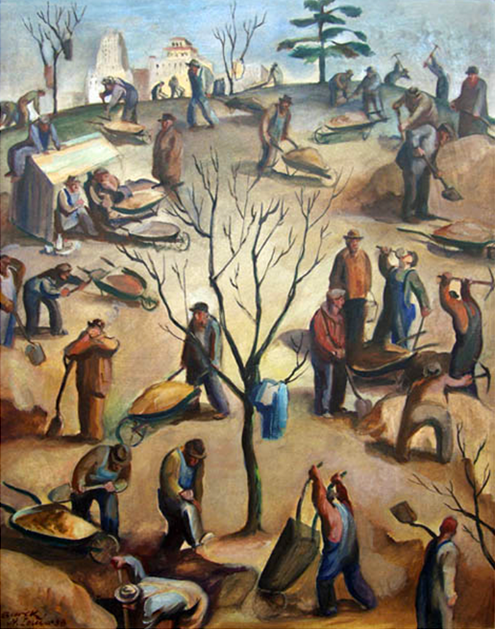Planting Trees in Forest Park, c.1938
Oil and tempera on canvas 23 ½ inches x 15 ½ inches
Saint Louis Mercantile Library – University of Missouri Saint Louis
The Mercantile Library in St. Louis, Missouri houses various pieces of art, one of which is a small-scaled painting entitled Planting Trees in Forest Park created by Jacob Burck around the year 1938. This painting depicts male workers digging holes and planting trees in Forest Park. The context is somewhat unclear; the viewer is not aware of the exact time period or circumstances of the painting. Could this be Burck’s theorized image of the construction of Forest Park for the 1904 World’s Fair? If so, this painting represents an exciting time for St. Louis, however, clearly painstaking. Because of these laborers, “Forest Park was a success…it brought dramatic increases in real-estate values, construction contracts and jobs, and the prestige required to attract the 1904 World’s Fair.” (Couvares 515)
Consequentially, the city of St. Louis became recognized as a great cultural center. However, there were opposing arguments on the new park. “The fair destroyed forever the ‘magnificent wilderness’ that occupied the western half of the park.” (Couvares 515) The Gateway to the West is a popular nickname for St. Louis, therefore losing a large mass of untouched western wilderness could understandably cause unrest. The subject of Burck’s Planting Trees in Forest Park may be the restoration of the badly damaged park after the World’s Fair. There was a “nine-year wrangle between the fair’s commissioners and the city over the postfair restoration of the park…” and the park therefore was “an essential element in the politics of development.” (Couvares 515) Perhaps this is why the laborers are replanting young trees.
Whether the working men in the painting are preparing St. Louis for the 1904 World’s Fair or restoring and rejuvenating the park after the fair’s destruction, this painting ultimately portrays the hard work that was required to beautify St. Louis. Although some wilderness may have been lost due to city development, it is easy to appreciate living in a thoughtfully designed city and to have a library to remind us of how it came to be.
Couvares, Francis G. “Review: untitled.” The American Historical Review. 93.2 (April, 1988): 515.
By Bailey Dolenc

